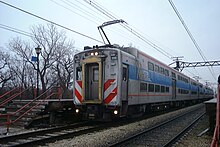Metra
The present system dates to 1974, when the Illinois General Assembly established the Regional Transportation Authority (RTA) to consolidate transit operations in the Chicago area, including commuter rail as a public utility.
The RTA's creation was a result of the anticipated withdrawal of commuter service operated and owned by various private railroad companies in the 1970s.
[6] Since its inception, Metra has directed more than $5 billion into the commuter rail system of the Chicago metropolitan area alongside the CTA.
In January 2023, Metra rolled out a new real-time train tracking website to allow passengers greater visibility into their commute.
The Burlington Northern, Milwaukee Road, Chicago and North Western and Illinois Central had been losing money for several years, and were using trainsets with passenger cars dating as far back as the 1920s.
[9] To provide stability to the commuter rail system, the Illinois General Assembly formed the Regional Transportation Authority in 1974.
[9] The companies that had long provided commuter rail in the Chicago area continued to operate their lines under contract to the RTA.
It was also responsible for directing fare and service levels, setting up budgets, finding sources for capital investment and planning.
Four other routes continue to be operated by Union Pacific (formerly Chicago & North Western) and BNSF (formerly Burlington Northern) under contract to Metra.
That investment has been used to purchase new rolling stock, build new stations, renovate tracks, modernize signal systems and upgrade support facilities.
[15] In 2023, Metra announced plans to extend the Milwaukee District West Line to Rockford, Illinois, with intermediate stops at Huntley and Belvidere, by 2027.
[17] Such an agreement would require contracts with the two freight railroads - Canadian National, which owns some of the NCS track, and CPKC, which dispatches trains on another portion of the route.
[18] Additionally, improved service to O'Hare would likely require major infrastructure upgrades to track, sidings, crossovers, and flyovers, with the potential for dedicated rolling stock another consideration.
In April 2002, board member Don Udstuen resigned from both Metra and his executive job with the Illinois State Medical Society, after admitting to taking bribes to steer Metra contracts to firms associated with former legislator Roger Stanley and pleading guilty to his part in Illinois's Operation Safe Road scandal.
[19] In April 2010, Metra's executive director, Phil Pagano, faced investigation for taking an unauthorized $56,000 bonus and was later found to have improperly received $475,000 in vacation pay.
The day that the agency's board was scheduled to discuss his fate, Pagano stepped in front of a moving Metra train in an apparent suicide.
The three Union Pacific lines originate at Ogilvie Transportation Center, formerly and still popularly called North Western Station.
█ Heritage Corridor █ Metra Electric █ Milwaukee District North █ Milwaukee District West █ North Central Service █ Rock Island █ SouthWest Service █ Union Pacific North █ Union Pacific Northwest █ Union Pacific West Metra proposed two routes in the early 2000s: the SouthEast Service, which would connect some portions of the southern suburbs with downtown Chicago; and the Suburban Transit Access Route, which would connect various suburbs with each other without going into downtown.
Chicago Eastern Illinois operated commuter service on this line out of Dearborn Station to Dolton and Momence, respectively.
This includes building and maintaining existing tracks, stations, signals, and other equipment that ensures a safe operating environment for all of Metra's passengers.
The group has some experience in this sector previously as Parsons worked with the southern California commuter rail agency Metrolink to install their system.
Some pre-college students, youth, senior citizens, members of the United States Armed Forces and persons with disabilities may qualify for these programs.
Time-based and geographical restrictions apply to these programs and passengers must ensure they qualify before attempting to purchase special tickets or ride for free.
Although rail transport is one of the safest forms of land travel,[73] compromises to Metra's safety and security can occur through pedestrian accidents, suicide attempts, vehicle collisions, derailment, terrorism and other incidents.
Failing to maintain safety and security can result in equipment and infrastructure damage, extensive service disruptions, traumatic injuries and loss of life.
Therefore, Metra and other agencies consider safety a top priority and dedicate a significant amount of resources to combat these dangers.
When asked why there were increasing patrols spokesman Michael Gillis said, "There is no particular reason, other than the fact that we want to be more proactive and more deliberately visible to our riders".
[77] The setup of railway platforms, use of grade crossing signals and horn blasts make up a critical system used to communicate movements of commuter trains to pedestrians and vehicles.
The 1972 Chicago commuter rail crash consisted of a two train collision on the Metra Electric, then under the control of the Illinois Central.
In addition to the loss of life, injuries, damage and service disruptions caused by accidents, Metra and other transportation agencies have been involved in multimillion-dollar lawsuits and settlements stemming from safety failures.








